Wireless Battery Charger: Analysis of Problems and Proposed Solutions
VerifiedAdded on 2023/04/10
|5
|840
|281
Report
AI Summary
This report examines the current technological issues facing wireless battery chargers, including low service range, complicated internal structures leading to higher costs, and signal losses that reduce efficiency. The proposed solutions involve improving the operating frequency to overcome signal and energy loss, and simplifying circuitry by removing DC-DC conversions to reduce costs and improve efficiency. The report highlights the need for approval from the Head of Business Operations, Project Manager, and Project Sponsor to implement these improvements. The benefits of the project include addressing existing problems within wireless chargers and meeting customer expectations, with references to relevant research in the field.
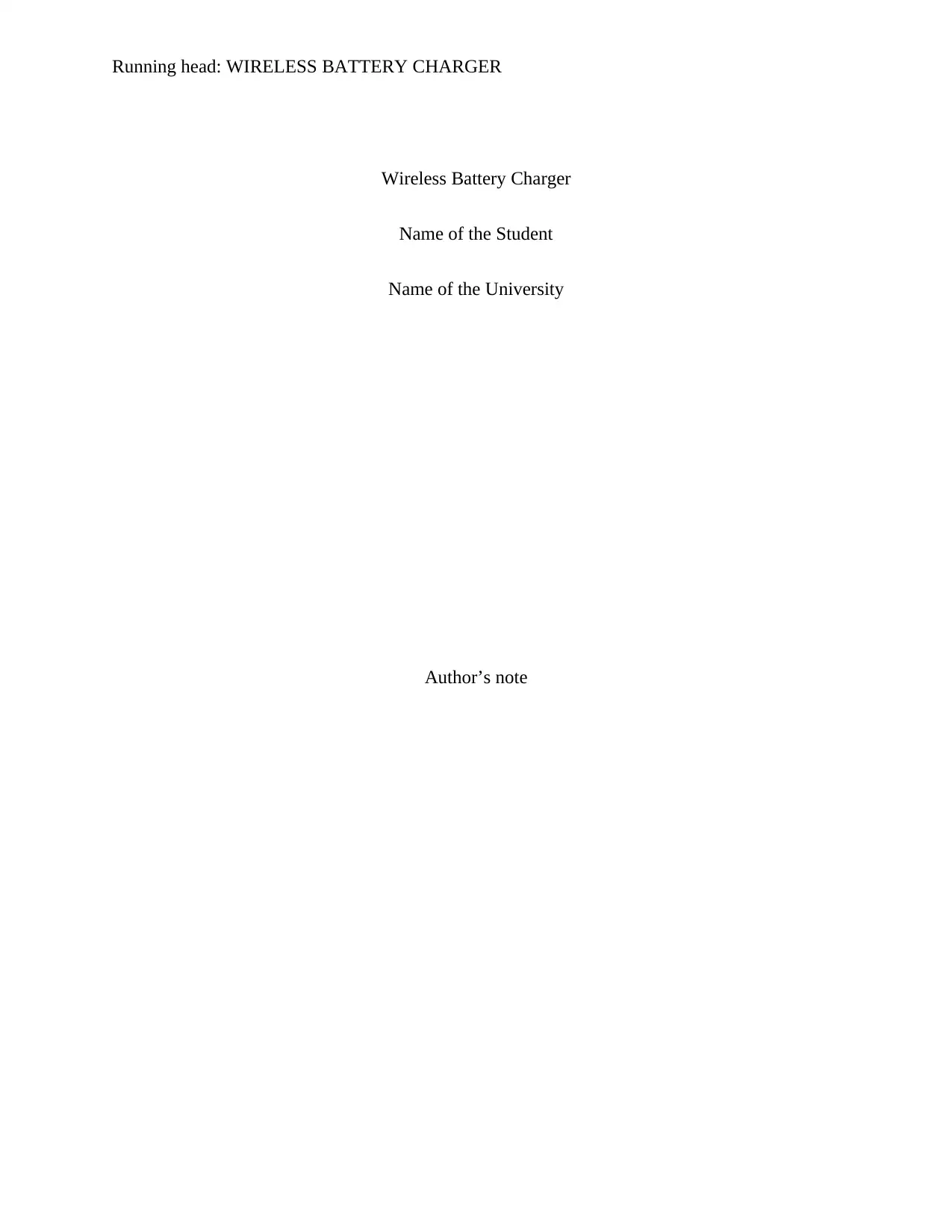
Running head: WIRELESS BATTERY CHARGER
Wireless Battery Charger
Name of the Student
Name of the University
Author’s note
Wireless Battery Charger
Name of the Student
Name of the University
Author’s note
Paraphrase This Document
Need a fresh take? Get an instant paraphrase of this document with our AI Paraphraser
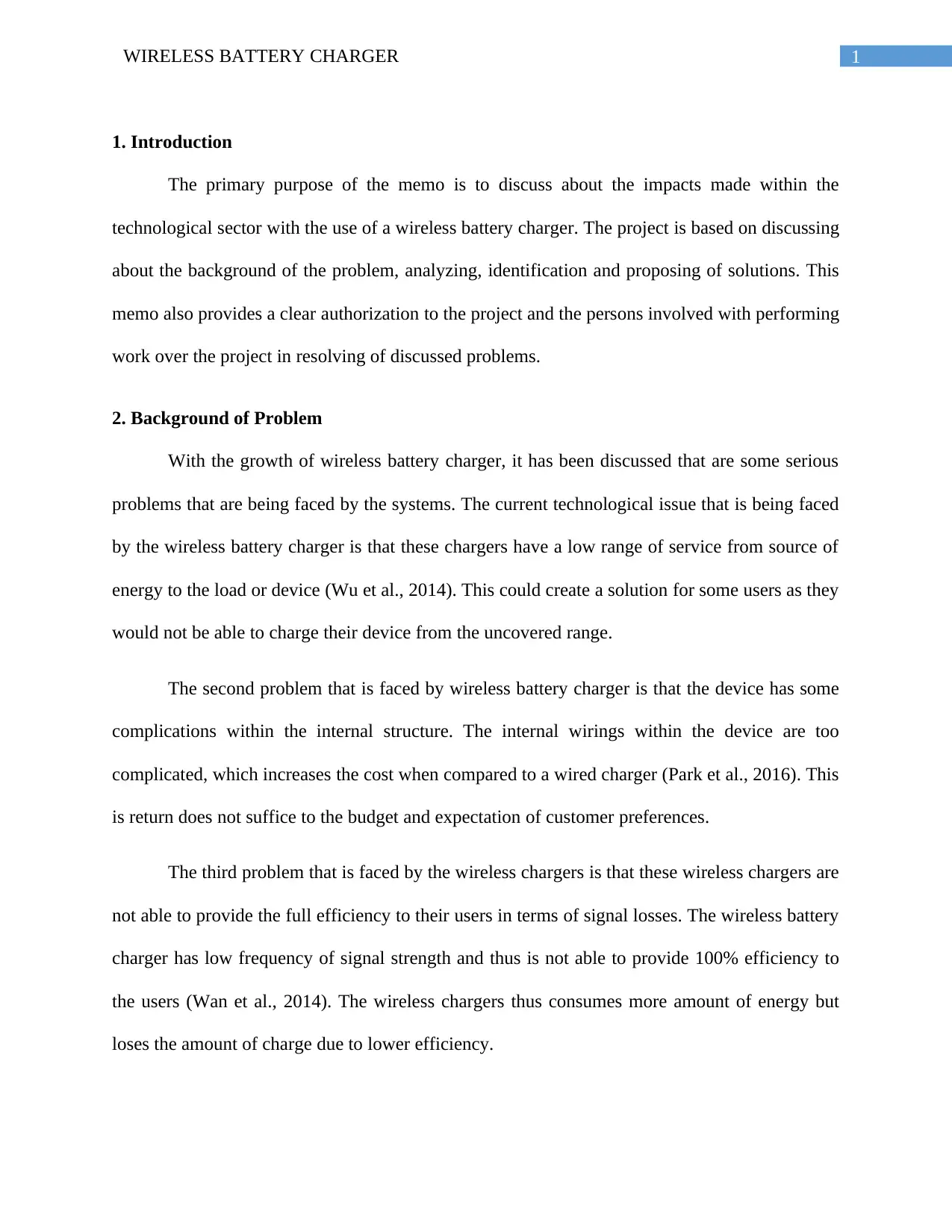
1WIRELESS BATTERY CHARGER
1. Introduction
The primary purpose of the memo is to discuss about the impacts made within the
technological sector with the use of a wireless battery charger. The project is based on discussing
about the background of the problem, analyzing, identification and proposing of solutions. This
memo also provides a clear authorization to the project and the persons involved with performing
work over the project in resolving of discussed problems.
2. Background of Problem
With the growth of wireless battery charger, it has been discussed that are some serious
problems that are being faced by the systems. The current technological issue that is being faced
by the wireless battery charger is that these chargers have a low range of service from source of
energy to the load or device (Wu et al., 2014). This could create a solution for some users as they
would not be able to charge their device from the uncovered range.
The second problem that is faced by wireless battery charger is that the device has some
complications within the internal structure. The internal wirings within the device are too
complicated, which increases the cost when compared to a wired charger (Park et al., 2016). This
is return does not suffice to the budget and expectation of customer preferences.
The third problem that is faced by the wireless chargers is that these wireless chargers are
not able to provide the full efficiency to their users in terms of signal losses. The wireless battery
charger has low frequency of signal strength and thus is not able to provide 100% efficiency to
the users (Wan et al., 2014). The wireless chargers thus consumes more amount of energy but
loses the amount of charge due to lower efficiency.
1. Introduction
The primary purpose of the memo is to discuss about the impacts made within the
technological sector with the use of a wireless battery charger. The project is based on discussing
about the background of the problem, analyzing, identification and proposing of solutions. This
memo also provides a clear authorization to the project and the persons involved with performing
work over the project in resolving of discussed problems.
2. Background of Problem
With the growth of wireless battery charger, it has been discussed that are some serious
problems that are being faced by the systems. The current technological issue that is being faced
by the wireless battery charger is that these chargers have a low range of service from source of
energy to the load or device (Wu et al., 2014). This could create a solution for some users as they
would not be able to charge their device from the uncovered range.
The second problem that is faced by wireless battery charger is that the device has some
complications within the internal structure. The internal wirings within the device are too
complicated, which increases the cost when compared to a wired charger (Park et al., 2016). This
is return does not suffice to the budget and expectation of customer preferences.
The third problem that is faced by the wireless chargers is that these wireless chargers are
not able to provide the full efficiency to their users in terms of signal losses. The wireless battery
charger has low frequency of signal strength and thus is not able to provide 100% efficiency to
the users (Wan et al., 2014). The wireless chargers thus consumes more amount of energy but
loses the amount of charge due to lower efficiency.
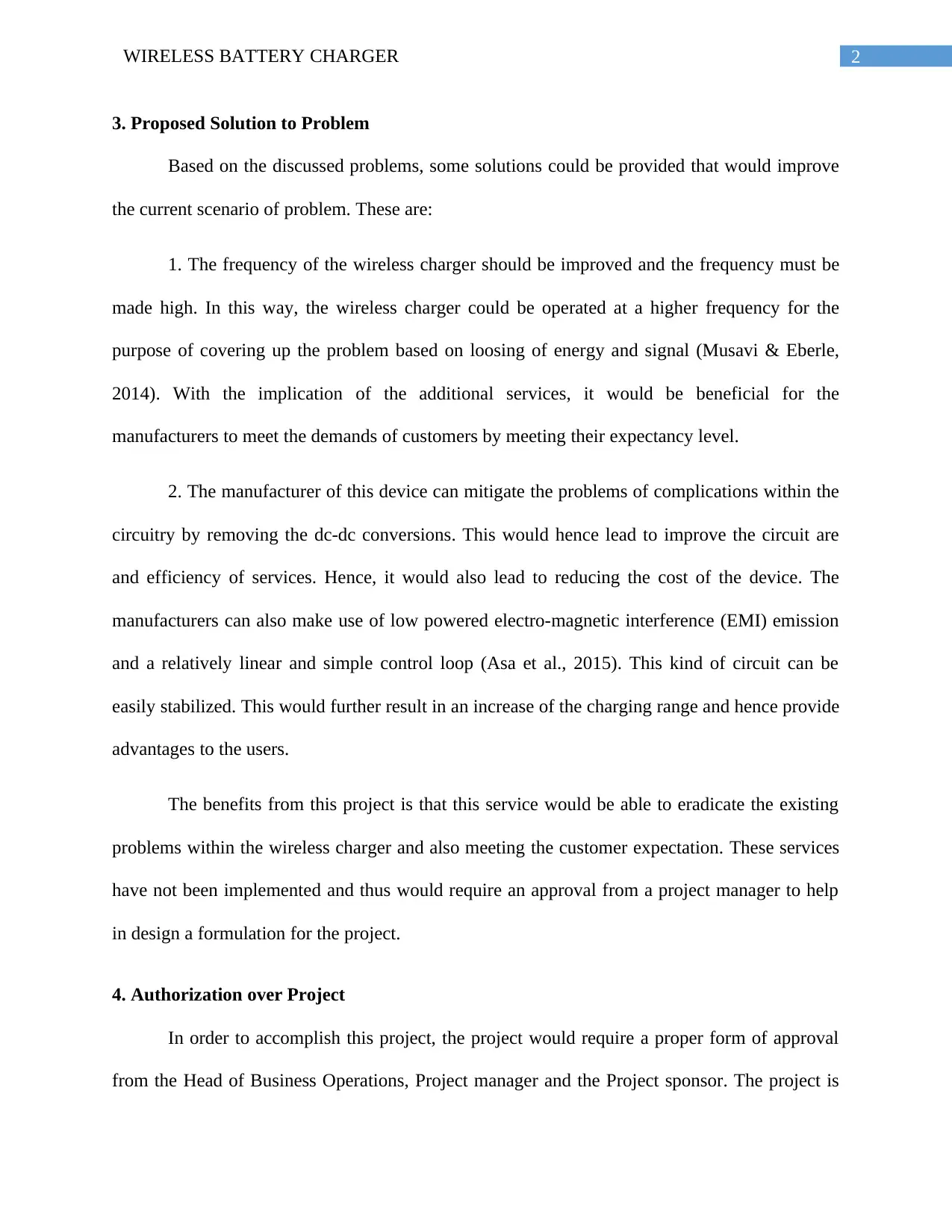
2WIRELESS BATTERY CHARGER
3. Proposed Solution to Problem
Based on the discussed problems, some solutions could be provided that would improve
the current scenario of problem. These are:
1. The frequency of the wireless charger should be improved and the frequency must be
made high. In this way, the wireless charger could be operated at a higher frequency for the
purpose of covering up the problem based on loosing of energy and signal (Musavi & Eberle,
2014). With the implication of the additional services, it would be beneficial for the
manufacturers to meet the demands of customers by meeting their expectancy level.
2. The manufacturer of this device can mitigate the problems of complications within the
circuitry by removing the dc-dc conversions. This would hence lead to improve the circuit are
and efficiency of services. Hence, it would also lead to reducing the cost of the device. The
manufacturers can also make use of low powered electro-magnetic interference (EMI) emission
and a relatively linear and simple control loop (Asa et al., 2015). This kind of circuit can be
easily stabilized. This would further result in an increase of the charging range and hence provide
advantages to the users.
The benefits from this project is that this service would be able to eradicate the existing
problems within the wireless charger and also meeting the customer expectation. These services
have not been implemented and thus would require an approval from a project manager to help
in design a formulation for the project.
4. Authorization over Project
In order to accomplish this project, the project would require a proper form of approval
from the Head of Business Operations, Project manager and the Project sponsor. The project is
3. Proposed Solution to Problem
Based on the discussed problems, some solutions could be provided that would improve
the current scenario of problem. These are:
1. The frequency of the wireless charger should be improved and the frequency must be
made high. In this way, the wireless charger could be operated at a higher frequency for the
purpose of covering up the problem based on loosing of energy and signal (Musavi & Eberle,
2014). With the implication of the additional services, it would be beneficial for the
manufacturers to meet the demands of customers by meeting their expectancy level.
2. The manufacturer of this device can mitigate the problems of complications within the
circuitry by removing the dc-dc conversions. This would hence lead to improve the circuit are
and efficiency of services. Hence, it would also lead to reducing the cost of the device. The
manufacturers can also make use of low powered electro-magnetic interference (EMI) emission
and a relatively linear and simple control loop (Asa et al., 2015). This kind of circuit can be
easily stabilized. This would further result in an increase of the charging range and hence provide
advantages to the users.
The benefits from this project is that this service would be able to eradicate the existing
problems within the wireless charger and also meeting the customer expectation. These services
have not been implemented and thus would require an approval from a project manager to help
in design a formulation for the project.
4. Authorization over Project
In order to accomplish this project, the project would require a proper form of approval
from the Head of Business Operations, Project manager and the Project sponsor. The project is
⊘ This is a preview!⊘
Do you want full access?
Subscribe today to unlock all pages.

Trusted by 1+ million students worldwide
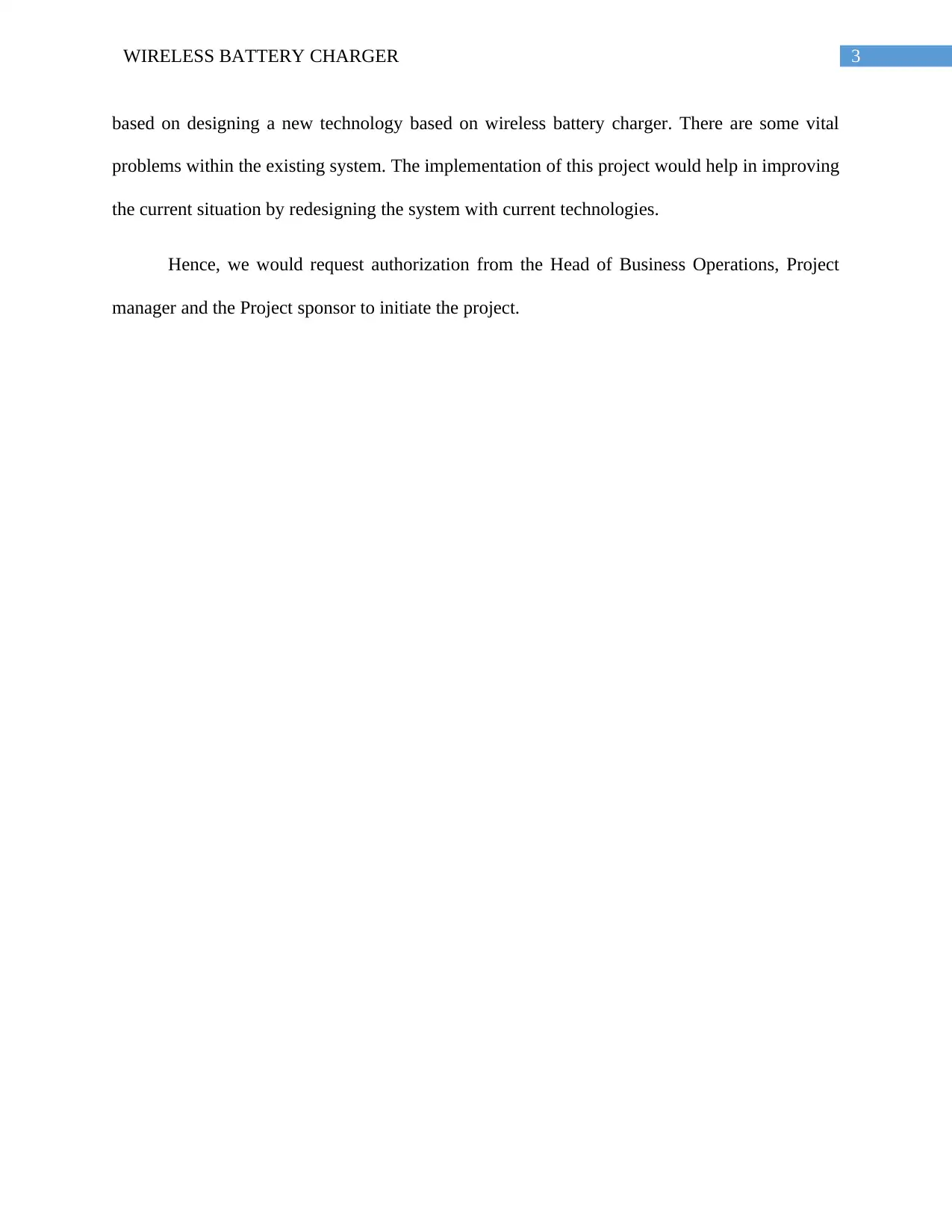
3WIRELESS BATTERY CHARGER
based on designing a new technology based on wireless battery charger. There are some vital
problems within the existing system. The implementation of this project would help in improving
the current situation by redesigning the system with current technologies.
Hence, we would request authorization from the Head of Business Operations, Project
manager and the Project sponsor to initiate the project.
based on designing a new technology based on wireless battery charger. There are some vital
problems within the existing system. The implementation of this project would help in improving
the current situation by redesigning the system with current technologies.
Hence, we would request authorization from the Head of Business Operations, Project
manager and the Project sponsor to initiate the project.
Paraphrase This Document
Need a fresh take? Get an instant paraphrase of this document with our AI Paraphraser
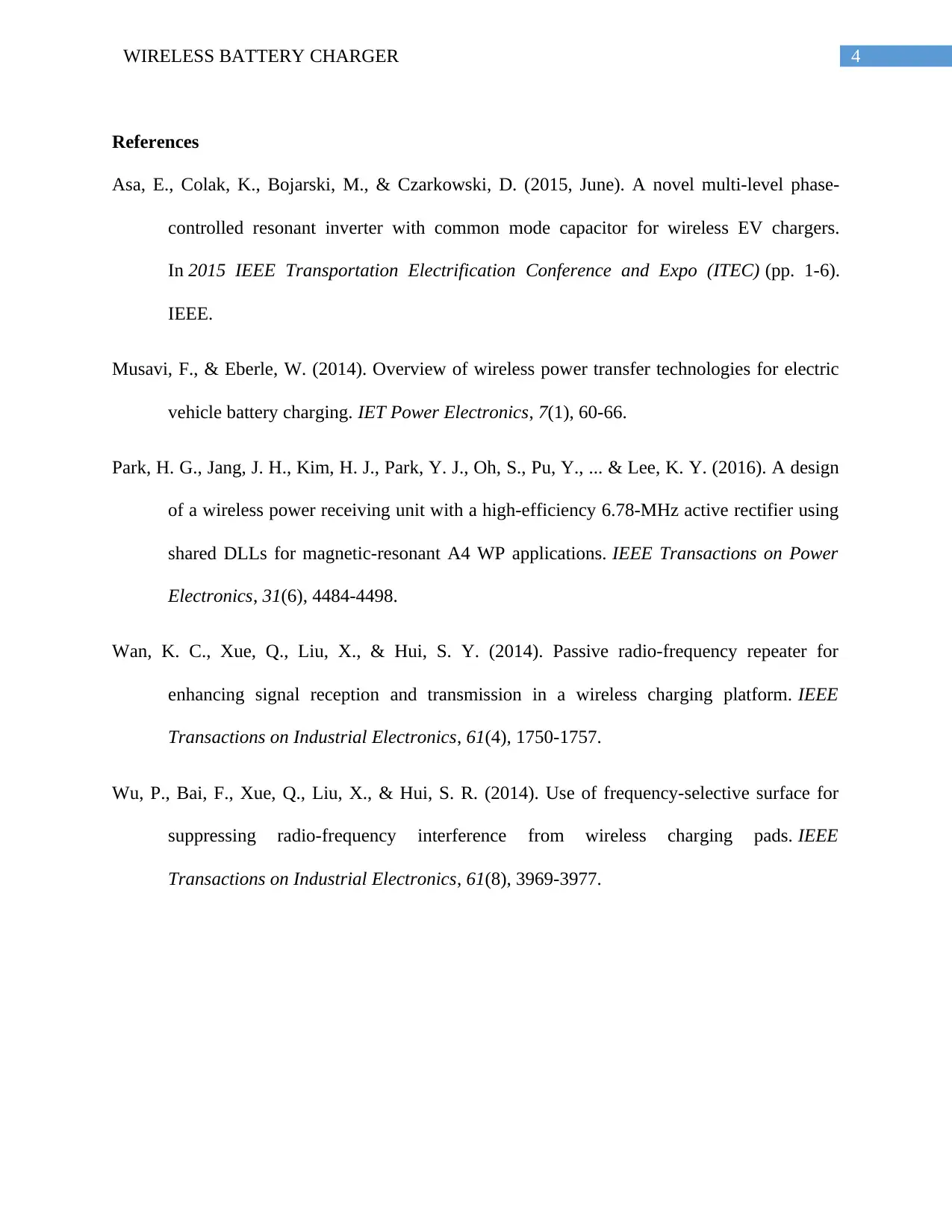
4WIRELESS BATTERY CHARGER
References
Asa, E., Colak, K., Bojarski, M., & Czarkowski, D. (2015, June). A novel multi-level phase-
controlled resonant inverter with common mode capacitor for wireless EV chargers.
In 2015 IEEE Transportation Electrification Conference and Expo (ITEC) (pp. 1-6).
IEEE.
Musavi, F., & Eberle, W. (2014). Overview of wireless power transfer technologies for electric
vehicle battery charging. IET Power Electronics, 7(1), 60-66.
Park, H. G., Jang, J. H., Kim, H. J., Park, Y. J., Oh, S., Pu, Y., ... & Lee, K. Y. (2016). A design
of a wireless power receiving unit with a high-efficiency 6.78-MHz active rectifier using
shared DLLs for magnetic-resonant A4 WP applications. IEEE Transactions on Power
Electronics, 31(6), 4484-4498.
Wan, K. C., Xue, Q., Liu, X., & Hui, S. Y. (2014). Passive radio-frequency repeater for
enhancing signal reception and transmission in a wireless charging platform. IEEE
Transactions on Industrial Electronics, 61(4), 1750-1757.
Wu, P., Bai, F., Xue, Q., Liu, X., & Hui, S. R. (2014). Use of frequency-selective surface for
suppressing radio-frequency interference from wireless charging pads. IEEE
Transactions on Industrial Electronics, 61(8), 3969-3977.
References
Asa, E., Colak, K., Bojarski, M., & Czarkowski, D. (2015, June). A novel multi-level phase-
controlled resonant inverter with common mode capacitor for wireless EV chargers.
In 2015 IEEE Transportation Electrification Conference and Expo (ITEC) (pp. 1-6).
IEEE.
Musavi, F., & Eberle, W. (2014). Overview of wireless power transfer technologies for electric
vehicle battery charging. IET Power Electronics, 7(1), 60-66.
Park, H. G., Jang, J. H., Kim, H. J., Park, Y. J., Oh, S., Pu, Y., ... & Lee, K. Y. (2016). A design
of a wireless power receiving unit with a high-efficiency 6.78-MHz active rectifier using
shared DLLs for magnetic-resonant A4 WP applications. IEEE Transactions on Power
Electronics, 31(6), 4484-4498.
Wan, K. C., Xue, Q., Liu, X., & Hui, S. Y. (2014). Passive radio-frequency repeater for
enhancing signal reception and transmission in a wireless charging platform. IEEE
Transactions on Industrial Electronics, 61(4), 1750-1757.
Wu, P., Bai, F., Xue, Q., Liu, X., & Hui, S. R. (2014). Use of frequency-selective surface for
suppressing radio-frequency interference from wireless charging pads. IEEE
Transactions on Industrial Electronics, 61(8), 3969-3977.
1 out of 5
Related Documents
Your All-in-One AI-Powered Toolkit for Academic Success.
+13062052269
info@desklib.com
Available 24*7 on WhatsApp / Email
![[object Object]](/_next/static/media/star-bottom.7253800d.svg)
Unlock your academic potential
Copyright © 2020–2025 A2Z Services. All Rights Reserved. Developed and managed by ZUCOL.




